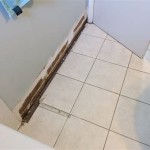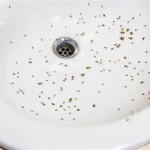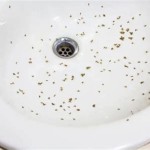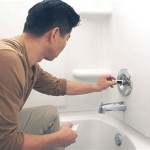How to Run Water Lines for a Bathroom Sink: A Comprehensive Guide
Installing or replacing water lines for a bathroom sink can seem daunting, but with careful planning, the right tools, and a methodical approach, it's a manageable DIY project. This article provides a detailed guide on how to run water lines for a bathroom sink, covering everything from planning and preparation to installation and testing.
Before embarking on this project, it's crucial to understand local plumbing codes. Regulations vary significantly depending on location. Failure to comply with these codes can result in fines and require rework. Consult with the local building department or a qualified plumbing inspector to ensure adherence to all applicable rules regarding materials, installation techniques, and required permits.
Safety should be the paramount concern throughout the entire process. Always turn off the main water supply to the house before beginning any plumbing work. This prevents uncontrolled water flow and potential flooding. Ensure the power is off to any electrical outlets or fixtures in the immediate vicinity of the work area. Consider wearing safety glasses to protect against debris and gloves to maintain a secure grip and protect hands.
Key Point 1: Planning and Preparation
Effective planning is the cornerstone of any successful plumbing project. This stage involves assessing the existing plumbing, choosing the appropriate materials, and gathering the necessary tools.
The first step is to inspect the existing plumbing. Determine the type of pipes currently in place (copper, PEX, CPVC, or galvanized steel) and their size. Note the location of the main water shut-off valve and any existing shut-off valves near the sink. Evaluate the accessibility of the existing plumbing and identify any potential obstacles, such as framing members or other utilities. Take detailed measurements of the distance between the existing water supply lines and the sink's faucet connections. This will help determine the length of supply lines needed.
Selecting the right materials is critical for a durable and leak-free installation. Common options for water supply lines include copper, PEX (cross-linked polyethylene), and flexible stainless-steel braided supply lines. Copper is a traditional choice known for its longevity, but it requires soldering or compression fittings, which can be challenging for beginners. PEX is a flexible plastic tubing that is easy to install using crimp or expansion fittings. Flexible stainless-steel braided supply lines offer ease of installation and flexibility, making them suitable for connecting the water supply to the faucet.
Consider the advantages and disadvantages of each material before making a decision. Copper is durable but requires specialized skills. PEX is relatively inexpensive and easy to install, but it may not be suitable for all water conditions. Flexible supply lines are convenient but may have a shorter lifespan than other options.
Gather all the necessary tools and materials before starting the installation. Essential tools include: pipe cutter (for copper or PEX), pipe wrench, adjustable wrench, tubing cutter (for flexible supply lines), crimp tool (for PEX), soldering equipment (if using copper), Teflon tape, pipe joint compound, safety glasses, gloves, and a bucket to catch any residual water. Materials include the chosen supply lines, shut-off valves (if replacing), fittings (couplings, elbows, tees), and mounting brackets (if needed).
Before beginning any cutting or disassembly, thoroughly clean the work area. Remove any obstructions and protect the surrounding surfaces with drop cloths or plastic sheeting. This will help prevent damage and keep the work area organized.
Key Point 2: Installation Process
With the planning and preparation complete, the next step is the actual installation of the water lines. This involves connecting the new supply lines to the existing plumbing and the sink faucet.
Begin by shutting off the water supply at the main shut-off valve. Open a faucet at the lowest point in the house to drain the water from the pipes. Once the water flow has stopped, proceed to disconnect the old supply lines from the existing plumbing and the faucet. Use appropriate wrenches to loosen and remove the connections. Be prepared for some residual water to drain from the pipes. Have a bucket handy to catch any spills.
If the old shut-off valves are corroded or damaged, it's advisable to replace them with new ones. This will ensure a reliable and leak-free connection. Use a pipe wrench to remove the old valves and clean the threads on the pipe. Apply Teflon tape or pipe joint compound to the threads of the new valves before screwing them into place. Make sure the valves are securely tightened, but avoid over-tightening, which can damage the threads.
Next, install the new water supply lines. If using copper pipes, cut the pipes to the appropriate length using a pipe cutter. Clean the ends of the pipes and fittings with a wire brush or emery cloth. Apply flux to the inside of the fittings and the outside of the pipes. Assemble the fittings and solder the joints using a torch. Allow the joints to cool completely before applying any pressure.
If using PEX tubing, measure and cut the tubing to the required length. Use a PEX crimp tool to attach the fittings to the tubing. Ensure the crimp rings are properly positioned and crimped according to the manufacturer's instructions. Double-check the crimps to ensure they are secure and leak-free.
If using flexible stainless-steel braided supply lines, simply connect the lines to the shut-off valves and the faucet connections. Tighten the connections by hand and then use a wrench to snug them up. Avoid over-tightening, which can damage the fittings.
Secure the water supply lines to the framing members using pipe clamps or brackets. This will prevent the lines from vibrating or moving, which can cause leaks over time. Ensure the lines are properly supported and protected from damage.
Key Point 3: Testing and Troubleshooting
Once the water lines are installed, it's essential to test them for leaks and troubleshoot any problems before putting the sink into regular use. Thorough testing will help ensure a reliable and leak-free plumbing system.
Slowly turn the water back on at the main shut-off valve. Check all connections for leaks. Pay close attention to the joints, fittings, and valves. If any leaks are detected, immediately turn off the water and tighten the connections or repair the joints. If the leak persists, disassemble the connection and reapply Teflon tape or pipe joint compound. In some cases, it may be necessary to replace the fitting or supply line.
After verifying that there are no leaks at the connections, check the water pressure at the faucet. Open the faucet and allow the water to flow for a few minutes. Check for any unusual noises or vibrations in the pipes. If the water pressure is low, check the shut-off valves to ensure they are fully open. Also, check for any kinks or obstructions in the supply lines.
Inspect the area under the sink for any signs of moisture or leaks. Use a flashlight to check the connections and supply lines for any drips or dampness. If any leaks are found, address them immediately to prevent water damage.
Once the water lines are tested and verified to be leak-free, insulate the pipes to prevent condensation and heat loss. Pipe insulation is available in various forms, including foam sleeves and wrap-around insulation. Insulating the pipes can also help reduce noise and prevent pipes from freezing in cold weather.
Dispose of any waste materials properly. Recycle any reusable materials and dispose of the remaining waste according to local regulations. Clean up the work area and remove any tools or equipment.
If any issues arise during the installation or testing process that are beyond one's skill level, it's best to consult with a qualified plumber. A professional plumber can diagnose and resolve complex plumbing problems and ensure the installation meets all applicable codes.
Running water lines for a bathroom sink requires careful planning, the right tools, and a methodical approach. By following these guidelines and taking the necessary precautions, the project can be completed safely and effectively.

How To Finish A Basement Bathroom Pex Plumbing

How To Run Pex Pipe A Vanity From The Main Water Line

Bathroom Sink Plumbing Installation Diy Montreal

Here S How Install A Bathroom Pedestal Sink

Bathroom Sink Plumbing Installation

Plumbing In The Walls

Replace Bathroom Sink Water Supply Lines

How To Install A Vessel Sink Faucet

How To Install Pex Pipe A Bathroom Sink Pkb Cabinetry

Bathroom Plumbing Rough In Dimensions The Home Depot
Related Posts







